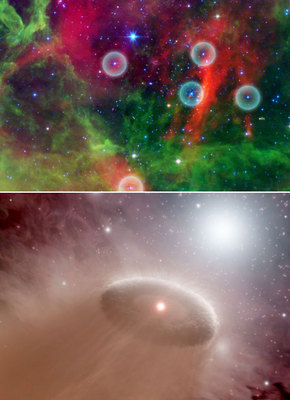Massive stars create "planetary danger zones" - regions of space where extreme solar winds and radiation make planets less likely to form, according to a new study.
The zones extended 1.6 light-years - about 10 trillion miles (16 trillion kilometers) - around so-called O-type stars, which are roughly 20 times bigger than our sun and a million times brighter.
Using NASA's Spitzer Space Telescope, the study team mapped out the Rosette Nebula, a stellar nursery where many stars have formed close together.
The team searched the nebula for protoplanetary disks - the gas, dust, and rocks that swirl around some stars. With time, gravity can pull the clumps of matter together to form planets.
But if the younger stars are in a danger zone, solar wind and radiation from the nearby O-stars tend to blow away their orbiting disks, the study suggests.
The stars and their disks "look like comets ... with a bright head and a tail," said study leader Zoltan Balog of the University of Arizona.

|
| ©NASA/JPL-Caltech/Z. Balog (Univ. of Ariz./Univ. of Szeged)
|
Every rose has its thorns: Spherical drawings highlight planetary "danger zones" scattered across the Rosette Nebula - a stellar nursery about 5,200 light-years from Earth - in an infrared image (top).
Smaller, relatively cool stars in these zones are at risk of having their planet-forming materials stripped away by extreme solar winds and radiation from much hotter stars nearby, as seen in an artist's illustration (bottom).
|
Dangerous BubblesThe new study mapped out hundreds of stars in the Rosette Nebula to find out how big planetary danger zones can get.
What they found is that beyond ten trillion miles from an O-star, about 45 percent of the neighboring stars had planet-forming disks.
But closer to the massive star, only 27 percent of the stars had disks, with fewer and fewer disks spotted around the small stars closest to the O-star.
If someone drew a ten-trillion-mile-wide bubble around one of these massive stars, outside of the bubble, planets would be as likely to form there as elsewhere.
But inside the bubble, stars would be more likely to have had their disks blown away, the study found.
Our solar system probably formed in a star nursery similar to the Rosette Nebula. But Balog said, "our sun probably didn't get too close to one of these massive stars."
Today our sun's closest star, Proxima Centauri, is nearly 30 trillion miles away.
A Lot of Earths?"I find it a very optimistic result," said Dimitar Sasselov of the Harvard-Smithsonian Center for Astrophysics in Cambridge, Massachusetts.
"The effect of these massive stars is only important in the near vicinity," he said, so stars outside the zones are still good candidates for planet formation.
But Sasselov and his colleague Scott Kenyon, also at the Center for Astrophysics, think that radiation from an O-star will tend to blow away just gas, and not dust or rocks, from any nearby protoplanetary disks.
This means that the formation of big gas planets similar to Jupiter may be more affected than the formation of smaller, rocky, Earthlike planets inside the zones, they said.
Henry Throop of the Southwest Research Institute at Boulder, Colorado, is skeptical about the new results.
But based on his work on another star-forming region, the Orion Nebula, he agrees that radiation from massive stars could favor the formation of rocky planets.
"We might actually expect to get a lot of Earths in systems like this," Throop said.
hollywood is a source of imminent danger to our planet.